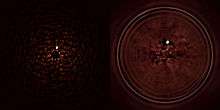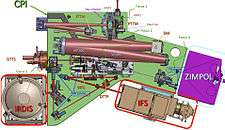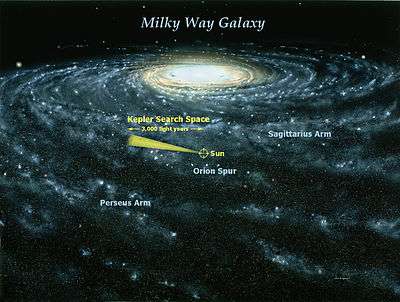Spectro-Polarimetric High-Contrast Exoplanet Research

Spectro-Polarimetric High-contrast Exoplanet REsearch (VLT-SPHERE) is an adaptive optics system and coronagraphic facility at the Very Large Telescope (VLT). It provides direct imaging as well as spectroscopic and polarimetric characterization of exoplanet systems. The instrument operates in the visible and near infrared, achieving, albeit over a limited field of view, superior image quality and contrast for bright targets.[1]
Results from SPHERE complement those from other planet finder projects which include HARPS, CoRoT, and the Kepler Mission.[2] The instrument was installed on Unit Telescope "Melipal" (UT3) and achieved first light in June, 2014. At the time of installation, it was the latest of a series of second generation VLT-instruments such as X-shooter, KMOS and MUSE.[3]
Science goals

Direct imaging of exoplanets is extremely challenging:
- The brightness contrast between the planet and its host star typically ranges from 10−6 for hot young giant planets emitting significant amounts of near-infrared light, to 10−9 for rocky planets seen exclusively through reflected light.
- The angular separation between the planet and its host star is very small. For a planet ∼10 AU from its host and tens of parsec away, the separation would be only a few tenths of an arcsec.[4]
SPHERE is representative of a second generation of instruments devoted towards direct high-contrast imaging of exoplanets. These combine advanced adaptive optics with high-efficiency coronagraphs to attenuate glare from the host star. In addition, SPHERE employs differential imaging to exploit differences between planetary and stellar light in terms of its color or polarization.[5] Other high-contrast imaging systems that are operational include Project 1640 at the Palomar Observatory and the Gemini Planet Imager at the Gemini South Telescope.[4] The Large Binocular Telescope, equipped with a less advanced adaptive optics system, has successfully imaged a variety of extrasolar planets.[6]
SPHERE is targeted towards direct detection of Jupiter-sized and larger planets separated from their host stars by 1 to 100 AU. Detecting and characterizing a large number of such planets should offer insight into planetary migration, the hypothetical process whereby hot Jupiters, which theory indicates cannot have formed as close to their host stars as they are found, migrate inwards from where they were formed in the protoplanetary disk.[7] It is also hypothesized that massive distant planets should be numerous; the results from SPHERE should clarify the extent to which the current observed preponderance of closely orbiting hot Jupiters represents observational bias. SPHERE observations will focus on the following types of targets:
- nearby young stellar associations which may also offer opportunities to detect low-mass planets;
- stars with known planets, in particular those with long-term residuals appearing in regression analysis of their radial velocity curves which could indicate the presence of more distant companions;
- the nearest stars, which would allow detecting targets with the smallest orbits, including those which shine only by reflected light;
- stars with ages in the 100 Myr to 1 Gyr range. In these young systems, even the smaller planets will still be hot and radiating copiously in the infrared, enabling lower detectable masses.
- SPHERE's high contrast capabilities should also enable it to be used in the study of protoplanetary discs, brown dwarfs, evolved massive stars, and to a lesser extent, in investigations of the Solar System and extragalactic targets.[2]
Results from SPHERE complement those of detection projects that use other detection methods such as radial velocity measurements and photometric transits. These projects include HARPS, CoRoT, and the Kepler Mission.[2]
Instrument description


SPHERE is installed on ESO’s VLT Unit Telescope 3 at the Nasmyth focus. It comprises the following subsystems:
- The Common Path and Infrastructure (CPI) is the main optical bench. It receives direct light from the telescope, and passes on stabilized, active-optics-corrected, and coronagraph-filtered beams to the three sub-instruments.
- The Integral Field Spectrograph (IFS) covers a 1.73" x 1.73" field of view, translating the spectral data into a three-dimensional (x,y,λ) data cube.
- The Infrared Dual-band Imager and Spectrograph (IRDIS) has a field of view of 11" x 12.5" with a pixel scale of 12.25 mas. IRDIS can provide classical imaging. Alternatively, it can be configured to provide simultaneous dual-band imaging using two different narrow bandpass filters targeting different spectral features, or it can be configured to provide simultaneous imaging from two crossed polarizers. When operating in long slit spectroscopy mode (LSS), a coronagraphic slit replaces the coronagraph mask.
- The Zurich Imaging Polarimeter (ZIMPOL) is a high contrast imaging polarimeter operating at the visual and infrared wavelengths, capable of achieving <30 mas resolution. It is also capable of diffraction limited classical imaging.[8]
Science results
.jpg)
Early results have validated the power of the SPHERE instrument, as well as presenting results that challenge existing theory.
- SPHERE discovered its first planet, HD 131399Ab, on June 12, 2015, which it confirmed in March and May 2016. The discovery spectrum reveals the presence of water and methane in the young planet's atmosphere. At 82 au from the primary star in the ~300 au triple system, the dynamics of the system are potentially more complex than for any other known exoplanet and must wait for future orbital characterization to determine its long term stability.
- SPHERE was used to search for a brown dwarf expected to be orbiting the eclipsing binary V471 Tauri. Careful measurements of eclipse timings had shown that they were not regular, but these irregularities could be explained by assuming that there was a brown dwarf perturbing the stars' orbits. Surprisingly, although the hypothetical brown dwarf should have been easily resolvable by SPHERE, no such companion was imaged. It would appear that the conventional explanation for the odd behavior of V471 Tauri is wrong. Several alternative explanations for the orbital timing variations have been proposed, including, for example, the possibility that the effects might be due to magnetic field variations in the primary member of the binary pair resulting in regular changes in shape of the star via the Applegate mechanism.[9][10]
- Another early SPHERE result is the first image of the spiral protoplanetary disk in HD 100453.[11] The global spiral pattern is a rare phenomena in circumstellar disks that is likely caused by the gravitational attraction of a massive body orbiting the star, such as another star or a giant planet. This disk is the first to have the perturbing companion imaged, providing a test for spiral arm generation theories. The images also reveal a gap extending from the edge of the coronagraphic mask to about the distance of Uranus' orbit in our own solar system.
References
- ↑ "SPHERE Overview". European Southern Observatory. Retrieved 23 May 2015.
- 1 2 3 Beuzit, Jean-Luc; et al. "SPHERE: a ‘Planet Finder’ Instrument for the VLT" (PDF). European Southern Observatory. Retrieved 24 May 2015.
- ↑ "First Light for SPHERE Exoplanet Imager". ESO. 4 June 2014.
- 1 2 Mesa, D.; Gratton, R.; Zurlo, A.; Vigan, A.; Claudi, R. U.; Alberi, M.; Antichi, J.; Baruffolo, A.; Beuzit, J. -L.; Boccaletti, A.; Bonnefoy, M.; Costille, A.; Desidera, S.; Dohlen, K.; Fantinel, D.; Feldt, M.; Fusco, T.; Giro, E.; Henning, T.; Kasper, M.; Langlois, M.; Maire, A. -L.; Martinez, P.; Moeller-Nilsson, O.; Mouillet, D.; Moutou, C.; Pavlov, A.; Puget, P.; Salasnich, B.; et al. (2015). "Performance of the VLT Planet Finder SPHERE". Astronomy & Astrophysics. 576: A121. Bibcode:2015A&A...576A.121M. arXiv:1503.02486
 . doi:10.1051/0004-6361/201423910.
. doi:10.1051/0004-6361/201423910. - ↑ "First Light for SPHERE Exoplanet Imager". European Southern Observatory. Retrieved 24 May 2015.
- ↑ Esposito, S.; Mesa, D.; Skemer, A.; Arcidiacono, C.; Claudi, R. U.; Desidera, S.; Gratton, R.; Mannucci, F.; Marzari, F.; Masciadri, E.; Close, L.; Hinz, P.; Kulesa, C.; McCarthy, D.; Males, J.; Agapito, G.; Argomedo, J.; Boutsia, K.; Briguglio, R.; Brusa, G.; Busoni, L.; Cresci, G.; Fini, L.; Fontana, A.; Guerra, J. C.; Hill, J. M.; Miller, D.; Paris, D.; Pinna, E.; et al. (2012). "LBT observations of the HR 8799 planetary system". Astronomy & Astrophysics. 549: A52. Bibcode:2013A&A...549A..52E. arXiv:1203.2735
 . doi:10.1051/0004-6361/201219212.
. doi:10.1051/0004-6361/201219212. - ↑ D'Angelo, G.; Lubow, S. H. (2008). "Evolution of Migrating Planets Undergoing Gas Accretion". The Astrophysical Journal. 685 (1): 560–583. Bibcode:2008ApJ...685..560D. arXiv:0806.1771
 . doi:10.1086/590904.
. doi:10.1086/590904. - ↑ "SPHERE - Instrument Description". European Southern Observatory. Retrieved 24 May 2015.
- ↑ "The Strange Case of the Missing Dwarf". European Southern Observatory. Retrieved 24 May 2015.
- ↑ Hardy, A.; Schreiber, M. R.; Parsons, S. G.; Caceres, C.; Retamales, G.; Wahhaj, Z.; Mawet, D.; Canovas, H.; Cieza, L. (2015-02-01). "The First Science Results from Sphere: Disproving the Predicted Brown Dwarf Around V471 Tau". The Astrophysical Journal Letters. 800: L24. Bibcode:2015ApJ...800L..24H. ISSN 0004-637X. arXiv:1502.05116
 . doi:10.1088/2041-8205/800/2/L24.
. doi:10.1088/2041-8205/800/2/L24. - ↑ Wagner, K.; Apai, D.; Kasper, M.; Robberto, M. (2015-10-22). "Discovery of a Two-armed Spiral Structure in the Gapped Disk around Herbig Ae Star HD 100453". The Astrophysical Journal Letters. 813: L2. Bibcode:2015ApJ...813L...2W. arXiv:1510.02212
 . doi:10.1088/2041-8205/813/1/L2.
. doi:10.1088/2041-8205/813/1/L2.
External links
Coordinates: 24°37′39″S 70°24′16″W / 24.6274°S 70.4044°W


